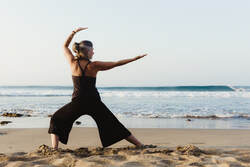|
3 Part Breath I wrote a post the other day about my first yoga class where we were taught "3-part-breath", or "yogic breathing", and that I learned in that first class that my own breath pattern - my habitual and unconscious breath pattern - was actually the opposite of this and called "reverse breathing". I think of 3-part-breath as our natural breathing pattern. It's natural to us, but often lost as we navigate life and the inevitable stresses, conditioning and trauma of being in a body in this world. If you watch babies, and most young children and animals when they're relaxed, you'll notice that they're whole body moves in sync with the breath, in a coordinated way. The inhalation expands the lower belly, that expansion rises up into the rib cage, the ribs gently flair out & then the chest and collarbones expand. On the exhalation, the belly draws in toward the spine, and the cycle continues. It is a wave-like motion; the breath flows in & expands the abdomen, ribcage & chest, subtly arching the spine, then flows out, and the subtly flexes. With stress and trauma, or social conditioning, we might develop a habit of unconsciously bracing the abdomen, or holding the belly. This compromises the natural flow of our breath, and over time can cause a number of health issues. "Reverse breathing" means that instead of the belly expanding when we breath in, the chest expands, and the abdomen draws in. The good news is, that with time & patience, we can re-train the body to breath better. It is worth the effort, as every system of the body, and our life-force and energy levels are impacted by our way of breathing. A consistent yoga class with a teacher who understands the importance of breath, or a well rounded breathwork practice, starting with a breath assessment with a yoga therapist or qualified breathing specialist is a good way to start the process of re-establishing a natural and beneficial breathing pattern.
1 Comment
If you practice yoga, it is likely that you're heard some variation of this expression in the classes you attend: "Find ease within the effort of the posture", or "Find a steady, and relaxed seat". These instructions are inspired by Patanjali's Yoga Sutras, verse 2.46, which in Sanskrit is: Sthira sukham asanam. This sutra was the focus of the my Monday morning Hatha yoga class this week.
In class, when sitting in meditation posture, or practicing asana, we are invited to notice where we need to engage muscular effort. To sit in meditation, or to practice a posture correctly, we need to be attentive and alert. We need to engage certain muscles to find length in the spine, and to find alignment in a pose. The mental effort required is to be present, alert and attentive. This physical and mental effort, is "sthira": which can be translated to steady, strong, firm, alert. From a Taoist perspective, which underlies Tai Chi & Qigong and other martial arts practices, we strive to find equanimity, a dynamic play and balancing of the opposite energies of life, the "yin" & the "yang". So the "effort" we apply is the "yang" aspect of our practice. In the west, we tend to overemphasize this part. We strive. We compete. We apply a lot of effort. For many of us, it's out of balance, and we compare ourselves unfavourable with some inner ideal, a picture of how we should look in a posture, or with others. We are hard on ourselves. We look around us and hope that we "measure up" to some imagined standard. There are many examples of an overbalance of "yang" in our culture that we have internalized. But the yogic seers, the ancient Taoists, and many other wisdom traditions and Indigenous cultures knew the importance of balance. Yoga & Taoism both teach us that if we don't balance this physical effort with relaxation, and the mental effort with an attitude of compassion, we are at risk of causing damage. We can cause damage internally through over-exertion & stress to our nervous system. On the other side, of course, if it's all yielding, and relaxing, we just don't bother getting off the couch! So when we sit to meditate, when we practice yoga asana, we can meet the muscular effort with a balancing relaxation to those parts of the body we can relax. We can bring in an attitude of self-acceptance to balance our mental striving. The Sanskrit word "hatha", (hatha is the physical practice of yoga, the asanas, as opposed to Jnana yoga, or Bhakti yoga, or Mantra yoga). Hatha translates as "ha" sun, and "tha", moon. This refers to the balance of masculine aspects — active, hot, sun — and feminine aspects —receptivity, intuition, coolness, moon — within all of us. Hatha yoga is a path toward discovering the dynamic harmony within and between the opposites. So, back to our practice... In class, after we have moved into a tall seat or a posture, mentally scanned the body for good alignment, when we're engaging the appropriate muscles, and applying our focus and attention, we now turn our awareness to notice where we can soften. Where is there unnecessary tension or muscular holding in the body. And just as important, we can check our mental & emotional approach to what we're doing. How are we striving? Are we trying to achieve some outer ideal? Are we comparing ourselves to others? Can we settle back into the felt sense in the body, and soften our approach? Can we soften our mind? Bring in some kindness & compassion, some "sukham" (sweetness, pleasure, comfort). Maybe even brining in a metta phrase, such as "May I be at ease", "May my heart remain open". Our mat can be our training ground for refining our ability to make 'right effort', giving our attention and focus to the task at hand, AND being kind and compassionate. May our practice give us greater freedom to be equanimous in this dynamic dance of finding, losing, and regaining balance in the dynamic play of life. with love, Cedar |
AuthorCedar Sorensen ArchivesCategories |


 RSS Feed
RSS Feed